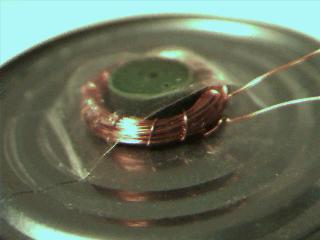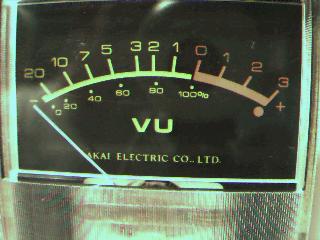
Goals: This lab activity was designed to get students involved with their own learning. My specific goals were to present my students with the opportunity to:
The materials:

As you can see in the image to the left, the materials are simple and inexpensive.
Students are to provide their own tin cans and button magnets. (Teachers, at first only a few students will bring in the materials. After seeing what the other kids are making, the remainder of the students will want to participate and will get the can and magnet.)
In addition to the tin can and button magnet a mini-phone jack with wire leads is needed. Some enamel coated wire is used to wind the coils. And some tape holds everything to the bottom of the can.

A close-up of the copper wire coil and magnet taped into position on the bottom of the can is shown at the right.
The mini-phone jack plugs into the headphone socket on a small transistor radio.

The VU Meter (Volume Units) of an old tape recorder is used to measure the volume generated by the speakers. Nothing needs to be tape recorded, we are merely using the meter for taking measurements. These measurements are recorded and needed by the students.
All equipment is crude, cheap, and available at most schools.
Variables: Students will be able to experiment with the following variables - I prefer to have my students create this variable list rather than providing it for them. (Note that the volume level of the radio must remain constant and is not to be a variable!):
Record keeping: Students need to design a data chart to record the VU's for each variable change they try. This information can also be graphed. It is a good idea for students to subjectively evaluate and record on their charts the "quality of sound produced". The loudest might not be the "best".
Conclusions: From their experiments students are to construct the best speaker possible (based on student criteria) and demonstrate it to others in the class.
Additional comments: I believe that your students will actually want to get involved with activity. Most students are interested in listening to music and are naturally interested in creating such speakers. Be prepared for "stereo headphones" to be made by several teams of student. Enjoy.